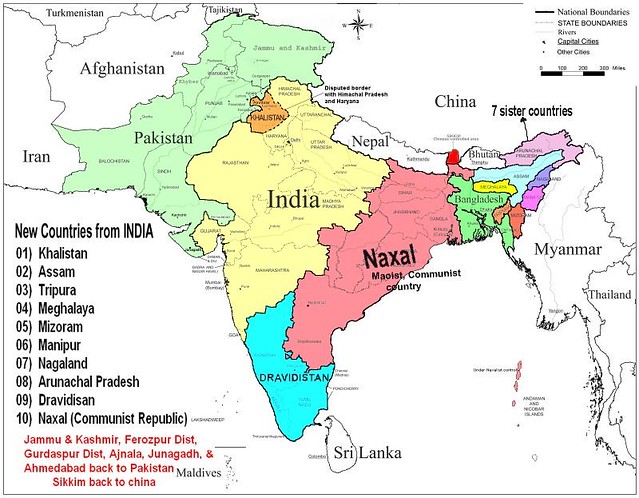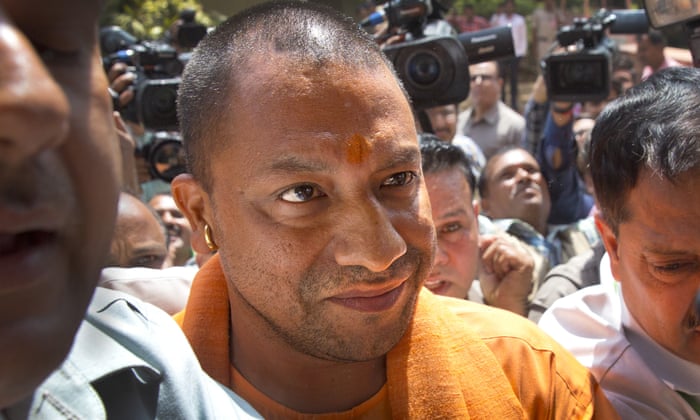India’s Brutal Tactics in Suppressing Separatist Movements
By Sajjad Shaukat
A large number of separatist movements in different parts of India are posing a serious threat to Indian federation, as Indian security forces have badly failed in suppressing these movements through brutal tactics.
In this respect, Naxalites or Maoists is second major freedom movement after that of the Indian Occupied Kashmir (IOK). Maoists inhabit an area known as the ‘Red Corridor’ that stretches from West Bengal to Karnataka state in the southwest. Indian former Prime Minister Manmohan Singh had called Maoist insurrection, “the single biggest internal-security challenge”, whereas, Home Secretary G.K Pillai reiterated the magnitude of this threat, saying that the Maoists want to completely overthrow the Indian state by 2050. Tamil Nadu is another area where separatist movements are haunting the Federation of India. However, in many regions of India, separatist movements or wars of liberation continue unabated.
In this regard, the seven states of Northeastern India, which are called the ‘Seven Sisters’ are ethnically and linguistically different from rest of the country. These states are rocked by a large number of armed and violent rebellions, some seeking separate states, some fighting for autonomy and others demanding complete independence while keeping the entire region in a state of turmoil. These states include Assam, Arunachal Pradesh, Meghalaya, Manipur, Mizoram, Nagaland and Tripura. These states accuse New Delhi of apathy towards their issues. Illiteracy, poverty and lack of economic opportunities have fueled the natives’ demand for autonomy and independence.
Owing to the political, economic and social injustices, tensions existed between these Northeastern states and the central government as well as amongst their native people and migrants from other parts of India. In late 2013, Indian state governments tried to ease tensions making by promising to raise the living standards of people in these regions. But, in late 2014, tensions again rose, as the Indian rulers launched an atrocious offensive which led to a retaliatory attack on civilians by tribal guerrillas.
Since the secessionist movements started in these states, Indian security forces have used various brutal tactics which brought about untold miseries on the people. In one way or the other, these atrocities still continue in these areas of North East India.
Undoubtedly, these states have witnessed various forms of India’s state terrorism like crackdowns, illegal detentions, massacre, targeted killings, sieges, burning the houses, torture, disappearances, rapes, breaking the legs, molestation of women and killing of persons through fake encounters.
It is notable that in 2015, the then Indian Minister of Home Affairs Rajnath Singh had highlighted his focus to build the capacity of security forces, engaged in fighting uprising and separatism. Indian Central Government finalized the raising of Indian Reserve Police Battalions (IRBPs) in the Indian Occupied Kashmir (IOK) and Naxal/Maoist hit states or Left Wing Extremism (LWE) areas, Andhra Pradesh and Telangana. Out of the total 25 IRBPs proposed, five were for IOK and 12 for LWE affected states whereas rest of 8, IRBPs for other states. Online reports suggested that IRBPs also include Northeastern states of India.
Now, IRBPs have totally failed in suppressing insurgency and separatist movements in various regions of India, including those of the North East.
It is mentionable that one of the important causes of the disintegration of the former Soviet Union was that its greater defence expenditure exceeded to the maximum, resulting in economic crises inside the country. In this connection, about a prolonged war in Afghanistan, the former President Gorbachev had declared it as the “bleeding wound.” However, the militarization of the Soviet Union failed in controlling the movements of liberation, launched by various ethnic nationalities which were kept under control through the ruthless force. While, learning no lesson from New Delhi’s previous close friend, Indian fundamentalist Prime Minister Narendra Modi of the BJP extremist party is acting upon the similar policies.
Instead of redressing the grievances of the people by eliminating injustices against them, Indian Government is depending upon ruthless force to crush these secessionist movements through security forces. Therefore, India’s unrealistic counterinsurgency strategy has badly failed.
Nevertheless, poor economic policies, heavy defence spending, neglected social development, growing serpent of radical Hinduism, ancient caste system and divisive/pressure politics are just few triggers of these secessionist movements.
India, instead of addressing actual domestic problems and peoples’ genuine grievances also resorts to blaming its neighbours for fueling these movements. In the pretext, New Delhi is also acting upon war-mongering policy against Pakistan and China.
It is also speculated that Indian government under the pretext of escalation of tension with China in Doklom region, will increase the number of armed forces in ‘Seven Sister’ regions, as an attempt to neutralize the uprisings there.
Again, it is noteworthy that the escalation of centrifugal tendencies, fostering insurgency and separatist movements in India is mainly due to complete failure of the Indian Government to address the root causes. This situation has a potential to lead to a domino effect in the South Asian region, which will be detrimental to regional security and peace.
It is of particular attention that Indian Minister of External Affairs Jaswant Singh who served the BJP for 30 years was expelled from the party for praising Mohammad Ali Jinnah (Founder of Pakistan) and echoing the pain of the Indian Muslims in his book, “Jinnah: India, Partition, Independence.”
While pointing out the BJP’s attitude towards the minorities, Singh wrote: “Every Muslim that lives in India is a loyal Indian…look into the eyes of Indian Muslims and see the pain.” He warned in his book, if such a policy continued, “India could have the third partition.”
In fact, taking cognizance of the separatist movements in India and New Delhi’s use of brutal force through the military in suppressing them, in one way or the other, Jaswant Singh has shown realistic approach in his book.
Nonetheless, we can conclude that under the mask of democracy and secularism, Indian subsequent regimes dominated by politicians from the Hindi heartland—Hindutva (Hindu nationalism) have used brutal tactics mercilessly in suppressing the separatist movements in various regions, including Assam, Arunachal Pradesh, Meghalaya, Manipur, Mizoram, Nagaland and Tripura. Under Modi’s extremist regime, these tactics have openly been employed by the Indian security forces. But, like the former Soviet Union, separatist movements which pose a serious threat to Indian federation, will culminate in the disintegration of the Indian union.
Sajjad Shaukat writes on international affairs and is the author of the book: US vs Islamic Militants, Invisible Balance of Power: Dangerous Shift in International Relations
Email: sajjad_logic_@yahoo.com
Additional Readings



-
Khalistan Freedom Movement.
-
Assam Separatist Movements.
-
Dravida Nadu.
-
Indian Occupied Kashmir Liberation Movement
-
Naxalite–Maoist insurgency.
ADDITIONAL INFORMATION ON SECESSIONIST MOVEMENTS IN INDIA
by
Sardar Zafar Mahmud Khan
HERE IS A LIST OF JUST SOME OF THESE SEPARATIST MOVEMENTS;
1. National Democratic Front of Bodoland (NDFB)
2. United People’s Democratic Solidarity (UPDS)
3. Kamtapur Liberation Organisation (KLO)
4. Bodo Liberation Tiger Force (BLTF)
5. Dima Halim Daogah (DHD)
6. Karbi National Volunteers (KNV)
7. Rabha National Security Force (RNSF)
8. Koch-Rajbongshi Liberation Organisation (KRLO)
9. Hmar People’s Convention- Democracy (HPC-D)
10. Karbi People’s Front (KPF)
11. Tiwa National Revolutionary Force (TNRF)
12. Bircha Commando Force (BCF)
13. Bengali Tiger Force (BTF)
Banner of the UNLF
Banner of the UNLF (Photo credit: Wikipedia)
14. Adivasi Security Force (ASF)
15. All Assam Adivasi Suraksha Samiti (AAASS)
16. Gorkha Tiger Force (GTF)
17. Barak Valley Youth Liberation Front (BVYLF)
18. United Liberation Front of Barak Valley
19. United National Liberation Front (UNLF)
20. People’s Liberation Army (PLA)
21. People’s Revolutionary Party of Kangleipak (PREPAK)
22. The above mentioned three groups now operate from a unified platform,
india kerala boat people
india kerala boat people (Photo credit: FriskoDude)
23. the Manipur People’s Liberation Front (MPLF)
24. Kangleipak Communist Party (KCP)
25. Kanglei Yawol Kanna Lup (KYKL)
26. Manipur Liberation Tiger Army (MLTA)
27. Iripak Kanba Lup (IKL)
28. People’s Republican Army (PRA)
29. Kangleipak Kanba Kanglup (KKK)
30. Kangleipak Liberation Organisation (KLO)
31. Revolutionary Joint Committee (RJC)
32. National Socialist Council of Nagaland — Isak-Muivah (NSCN-IM)
33. People’s United Liberation Front (PULF)
34. Kuki National Army (KNA)
35. Kuki Revolutionary Army (KRA)
36. Kuki National Organisation (KNO)
37. Kuki Independent Army (KIA)
English: Location of Jammu and Kashmir in India
Kashmiris dont think of themselves as Indians.English: Location of Jammu and Kashmir in India (Photo credit: Wikipedia)
38. Kuki Defence Force (KDF)
39. Kuki International Force (KIF)
40. Kuki National Volunteers (KNV)
41. Kuki Liberation Front (KLF)
42. Kuki Security Force (KSF)
43. Kuki Liberation Army (KLA)
44. Kuki Revolutionary Front (KRF)
45. United Kuki Liberation Front (UKLF)
46. Hmar People’s Convention (HPC)
47. Hmar People’s Convention- Democracy (HPC-D)
48. Hmar Revolutionary Front (HRF)
49. Zomi Revolutionary Army (ZRA)
50. Zomi Revolutionary Volunteers (ZRV)
51. Indigenous People’s Revolutionary Alliance(IRPA)
52. Kom Rem People’s Convention (KRPC)
53. Chin Kuki Revolutionary Front (CKRF)
54. Hynniewtrep National Liberation Council (HNLC)
55. Achik National Volunteer Council (ANVC)
56. People’s Liberation Front of Meghalaya (PLF-M)
57. Hajong United Liberation Army (HULA)
58. National Socialist Council of Nagaland (Isak-Muivah) – NSCN(IM)
59. National Socialist Council of Nagaland (Khaplang) – NSCN (K)
60. Naga National Council (Adino) – NNC (Adino)
61. Babbar Khalsa International (BKI)
62. Khalistan Zindabad Force (KZF)
63. International Sikh Youth Federation (ISYF)
64. Khalistan Commando Force (KCF)
65. All-India Sikh Students Federation (AISSF)
66. Bhindrawala Tigers Force of Khalistan (BTFK)
67. Khalistan Liberation Army (KLA)
68. Khalistan Liberation Front (KLF)
69. Khalistan Armed Force (KAF)
70. Dashmesh Regiment
71. Khalistan Liberation Organisation (KLO)
72. Khalistan National Army (KNA)
73. National Liberation Front of Tripura (NLFT)
74. All Tripura Tiger Force (ATTF)
75. Tripura Liberation Organisation Front (TLOF)
76. United Bengali Liberation Front (UBLF)
77. Tripura Tribal Volunteer Force (TTVF)
78. Tripura Armed Tribal Commando Force (TATCF)
79. Tripura Tribal Democratic Force (TTDF)
80. Tripura Tribal Youth Force (TTYF)
81. Tripura Liberation Force (TLF)
82. Tripura Defence Force (TDF)
83. All Tripura Volunteer Force (ATVF)
84. Tribal Commando Force (TCF)
85. Tripura Tribal Youth Force (TTYF)
86. All Tripura Bharat Suraksha Force (ATBSF)
87. Tripura Tribal Action Committee Force (TTACF) Socialist Democratic
88. Front of Tripura (SDFT)
89. All Tripura National Force (ATNF)
90. Tripura Tribal Sengkrak Force (TTSF)
91. Tiger Commando Force (TCF)
92. Tripura Mukti Police (TMP)
93. Tripura Rajya Raksha Bahini (TRRB)
94. Tripura State Volunteers (TSV)
95. Tripura National Democratic Tribal Force (TNDTF)
96. National Militia of Tripura (NMT)
97. All Tripura Bengali Regiment (ATBR)
98. Bangla Mukti Sena (BMS)
99. All Tripura Liberation Organisation (ATLO)
100. Tripura National Army (TNA)
101. Tripura State Volunteers (TSV)
102. Borok National Council of Tripura (BNCT)
103. Mizoram
104. Bru National Liberation Front
105. Hmar People’s Convention- Democracy (HPC-D)
106. Arunachal Pradesh
107. Arunachal Dragon Force (ADF)
108. Left-wing Extremist groups
109. People’s Guerrilla Army
110. People’s War Group
111. Maoist Communist Centre
112. Communist Party of India-Maoist (CPI-Maoist)
113. Communist Party of India (Marxist-Leninist) Janashakti Other Extremist Groups
114. Tamil National Retrieval Troops (TNRT)


![Click this image to show the full-size version. [IMG]](https://pbs.twimg.com/media/B9PQX28CEAEXpI8.jpg:large)
![Click this image to show the full-size version. [IMG]](https://pbs.twimg.com/media/B9PhV48CYAA_Ci7.jpg)
![Click this image to show the full-size version. [IMG]](https://pbs.twimg.com/media/B9OUiCeCQAA-toy.jpg)









